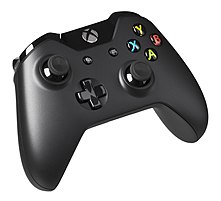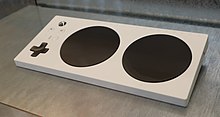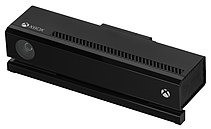Xbox One controller
The Xbox One console has a revised controller with forty improvements over the 360's controller. This new controller is built to work with Kinect. The Start and Back buttons are replaced with Menu and View buttons. It has impulse triggers that replace the regular triggers. The Xbox button still brings up the mini-guide as of recent dashboard versions, though in earlier iterations it brought up the main dashboard menu while leaving the game uninterrupted.
Xbox Series X and Series S Controller
The fourth generation Xbox Controller doesn't change much from the Xbox One controller, but the new wireless Xbox Controller does add a capture and share button, a hybrid d-pad, and better gripping on the bumpers and triggers.[78] The controller is also promised to be cross compatible with certain PC's and mobile devices.[79]
Xbox Adaptive Controller
The Xbox Adaptive Controller is a special controller designed for accessibility features for players. Besides being physically larger than typical controllers, it includes additional ports to allow other devices to be connected and mapped to other controller functions. The controller is not limited to just Xbox and Windows platforms but also is compatible with the PlayStation and Nintendo Switch.
Other accessories
Kinect
Kinect (stylized as KINECT) is a motion sensing input device by Microsoft for the Xbox 360 video game console and Windows PCs. Based around a webcam-style add-on peripheral for the Xbox 360 console, it enables users to control and interact with the Xbox 360 without the need to touch a game controller, through a natural user interface using gestures and spoken commands.[80] The project is aimed at broadening the Xbox 360's audience beyond its typical gamer base.[81] Kinect competes with the Wii Remote Plus and PlayStation Move with PlayStation Eye motion controllers for the Wii and PlayStation 3 home consoles, respectively. A version for Windows was released on February 1, 2012.[82]
Kinect was launched in North America on November 4, 2010,[83] in Europe on November 10, 2010,[84] in Australia, New Zealand and Singapore on November 18, 2010,[85][86][87] and in Japan on November 20, 2010.[88] Purchase options for the sensor peripheral include a bundle with the game Kinect Adventures and console bundles with either a 4 GB[89][90][91] or 250 GB[92] Xbox 360 console and Kinect Adventures.[89][90][91][92]
The Kinect claimed the Guinness World Record of being the "fastest selling consumer electronics device" after selling a total of 8 million units in its first 60 days.[93][94][95] 24 million units of the Kinect sensor had been shipped as of January 2012.[51]
Microsoft released Kinect software development kit for Windows 7 on June 16, 2011.[96][97][98] This SDK was meant to allow developers to write Kinecting apps in C++/CLI, C#, or Visual Basic .NET.[99][100]
Additional information on the Xbox One Kinect was released on June 6, 2013, including information on how to turn off the "always on" feature.[101]
Although featuring improved performance over the original Xbox 360 Kinect, its successor the Xbox One Kinect was subject to mixed responses. It was praised for its wide-angle, its fast response time and high-quality camera. However, the Kinect's inability to understand some accents in English was criticized. Furthermore, controversies surround Microsoft's intentional tying of the sensor with the Xbox One console despite the initial requirements for the sensor being plugged in at all times having been revised since its initial announcement. There have also been a number of concerns regarding privacy.
Headsets
When the Xbox Live online service was launched in 2002, the Xbox Communicator headset was included with the Live Starter Kit.[102] The Communicator, which enabled in-game voice chat, consisted of a wired headset and an interface module. The module plugged into the controller's top expansion slot, and the headset plugged into the module; the interface module was equipped with a dial to control volume and a button to mute the microphone.[103] The headset socket on the module was a standard 2.5mm TRS audio jack with monaural input and output, compatible with cellular phone headsets.
Xbox 360 controllers featured a built-in monaural 2.5mm TRS jack also compatible with standard cellular phone headsets, allowing players to reuse the Xbox Communicator headset and chat on Xbox Live without a separate interface module.[104] The premium console bundle included a wired Xbox 360 Live Communicator headset with grey and white cosmetics matching the console, which also was available separately;[105] the wired headset connected to the audio jack on the bottom of the controller through a wide plug that included mute and volume controls. An updated Xbox 360 Headset was released in 2010 with black cosmetics, bundled with the Xbox 360 S; for the revised wired headset, the mute/volume controls were moved to a position inline along the cable.
You received this message because you are subscribed to the Google Groups "1TopReadys1" group.
To unsubscribe from this group and stop receiving emails from it, send an email to 1topreadys1+unsubscribe@googlegroups.com.
To view this discussion on the web visit https://groups.google.com/d/msgid/1topreadys1/CAForgrR15R9zmHkwnbW7SsBM1xngvRGYs8xev5dUSkycj6fwcw%40mail.gmail.com.





No comments:
Post a Comment